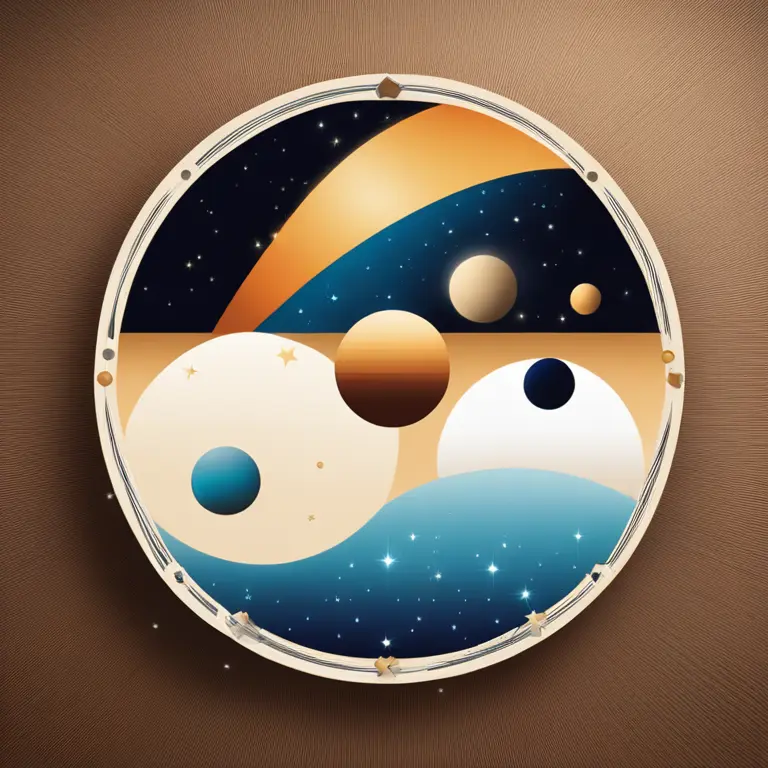
The Symbols of Astrological Aspects
Delve into the core significances of astrology aspect symbols in this concise guide to celestial influences in your horoscope.
article by Priya Deshmukh
The Zodiac Language
Astrology offers a rich language for understanding the influences of planets on human affairs. Central to this language are aspect symbols, each a crucial key for interpreting astrological charts. As a copywriter delving into the cosmic, you'll encounter these symbols, denoting the angles planets form with each other, suggesting harmonious or challenging dynamics. Astrological aspects represent the mathematical relationships—measured in degrees—between planets at a given moment, which are vital for insightful readings. The significance of understanding these symbols cannot be overemphasized; they are the grammar of the zodiac language that enables us to read the celestial script of individual fates and collective rhythms.

Conjunction: Unity and Intensity
The conjunction symbol (∠) represents an angle of approximately 0 degrees, where two planets are in the same zodiac sign. Conjunctions are points of power where the involved planetary energies merge intensively. This merging can manifest as an area of focus, strength, or sometimes tension, depending on the planets involved. In 2024 and beyond, astrologers continue to see conjunctions as opportunities for new beginnings, or as potent indicators of significant life events, depending on how they interact with individual birth charts.

Sextile: Opportunity and Talent
A sextile, marked by the asterisk-like symbol (*), indicates a 60-degree angle suggesting harmony and opportunity. This aspect fosters communication and collaboration between the energies of the planets involved. When a sextile occurs, talents and abilities often come to the foreground, allowing for growth and creative expression. In modern interpretations, sextiles urge us to seize opportunities and use our innate abilities to navigate life's journey.

Square: Challenge and Growth
The square, with its distinct L-shaped symbol (□), signifies a 90-degree angle between planets, revealing tension, conflict, or challenges. This aspect pushes for action, prompting internal growth through facing obstacles. While squares can cause frustration, the friction they create is believed to be necessary for development and can lead to significant breakthroughs in self-awareness and external achievements, especially as individuals familiarize themselves with this dynamic energy.

Trine: Harmony and Flow
The trine (∆) is a 120-degree angle often associated with harmony, ease, and natural talent. Trines indicate a flowing exchange of energy that can bring about ease and beneficial circumstances. Considered one of the most favorable aspects in astrology, trines are believed to bring forth luck, though some astrologers warn against complacency, urging individuals to actively utilize this supportive energy rather than taking it for granted.
Opposition: Balance and Perspective
Represented by the straight line (─), an opposition is a 180-degree aspect that suggests polarities or a tug of war between planetary energies. This aspect highlights areas of life that require balance and often reflect external relationships or conflicts seeking resolution. While oppositions can indicate struggles, they also provide unique perspectives, offering insights and the potential for profound understanding if navigated thoughtfully.
Published: 2/13/2024
Modified: 2/13/2024
More predictions
Come back here soon to learn more about yourself and your future


Crafting Inquiry: Top Tarot Questions to Ask
Discover the right questions to pose during a tarot reading to gain profound insights into your life's direction and decisions.


The Tarot Card Deck: A Gateway to Mystical Insights
Discover the tarot deck's rich symbolism and its role in personal growth and foresight. An insightful guide to the power of tarot cards.


The Tarot Queen of Cups: A Sign of Compassion and Insight
Delve into the symbolism and significance of the Queen of Cups in Tarot, uncovering her nurturing essence and intuitive power in divination.